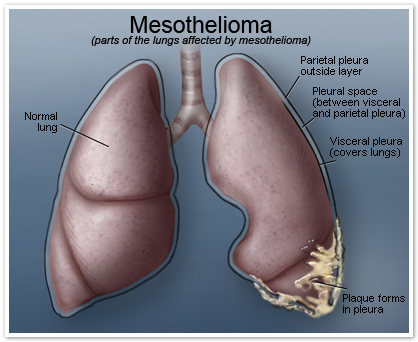What is mesothelioma?
Mesothelioma is a rare form of cancer that most frequently arises from the cells lining the sacs of the lungs or the abdomen . Mesothelial cells exist in the lining (membrane) that covers the outer
surface of our body organs. The majority of people with mesothelioma
have been exposed to asbestos at some time during their life.
There are two major cell types of mesothelioma, epithelial and sarcomatoid. Sometimes both of these cell types can be present. The sarcomatoid type is rarer and occurs in only about 15% of cases; it portends a poorer prognosis. In very rare cases, mesothelioma can originate from benign, non-malignant cells. This so-called benign mesothelioma can be cured surgically.
What are the symptoms of mesothelioma?
Most people present with complaints of shortness of breath. They also can have complaints of chest pain. Surprisingly, this pain is often not pleuritic; that is, it does not get worse with deep breathing. This is surprising in that the pleura (outer surface of the lung) is often involved in this disease, and most other diseases involving the pleura are often associated with pleuritic pain (pain that worsens with deep breathing). Patients may also be asymptomatic, with the disease discovered by physical exam or an abnormal chest X-ray.
As the disease progresses, shortness of breath increases, and weight loss, decreased appetite, and night sweats can develop. Local invasion by the tumor can result in changing of voice, loss of function of the diaphragm, and symptoms specific to the area and involvement of adjacent structures.
What causes mesothelioma?
Most people with malignant mesothelioma have worked on jobs where they breathed asbestos. Usually, this involves men over 40 years of age. Others have been exposed to asbestos in a household environment, often without knowing it. Interestingly, the number of new cases of mesothelioma has been relatively stable since 1983, the same time that the restrictions on asbestos were instituted by the U.S. Occupational Safety and Health Administration (OSHA). In Europe, the number of new cases of mesothelioma continues to rise.
How much asbestos exposure does it take to get mesothelioma?
An exposure of as little as one or two months can result in mesothelioma 30 or 40 years later and in some cases, as much as 70 years later.
How long does it take after asbestos exposure for mesothelioma to show up?
People exposed in the 1940s, '50s, '60s, and '70s are now being diagnosed with mesothelioma because of the long latency period of asbestos disease.

